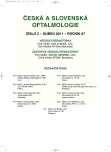EPI-LASEK – Our Experience
Authors:
Juhás T. Ml; T. Juhás
Authors‘ workplace:
Očná klinika UPJS a FNLP, Košice, vedúci prof. MUDr. T. Juhás, DrSc.
Published in:
Čes. a slov. Oftal., 67, 2011, No. 2, p. 56-59
Category:
Original Article
Overview
The aim of this study is to find advantages of alcohol assisted epithelial flap creation before surface excimer – laser refractive ablation.
Methods:
One hundred eyes undergoing Epi-Lasek with 20% alcohol in the beginning of procedure. Mean preoperative spherical equivalent was - 3.44 D ± 1.8 and/ from -1.0 to – 8.0 D/ spectacle – corrected visual acuity was from 1.0 to 0.8 in 100% eyes. All epithelial separations were performed with the Lasitome Gebauer. In the beginning of operation was used 20% alcohol for 15second.
Results:
The mean uncorrected visual acuity at 1 month after operation was from 1.0 to 0.8 in 92% eyes. After 12 months, the mean spherical equivalent was -0.262 ± 0.15D (from +0.50 to -0.75D). At 12 months no haze was observed.
Conclusion:
Our clinical results confirmed, that using 20 % alcohol or Epi-Lasek is contribution to refractive excimer surgery. Epi-Lasek enhances creation and separation of epithelial flap, leaves epithelial basal membrane attached to Bowmans layer and though creates optimal conditions for excimer laser surface ablation.
Key words:
excimer laser, Epi-Lasik, Epi-Lasek
Sources
1. Alio, J.L., Rodriguez, A.E., Mendez, M.C., Kanellopoulos, J.: Histopathology of epi-Lasik in eyes with virgin corneas and with previously altered corneas. J Cataract Refract Surg, 33, 2007; 11: 1871–1876.
2. Camellin, M., Wyler, D.: Epi-Lasik versus Epi-Lasek. J Refract Surg, 24, 2008; 4: S57–S63.
3. Gabler, B., Winkler von Mohrenfelset, C., Dreiss, A.K. et al.: Vitality of epithelial cells after alcohol exposure during laser-assisted subepithelial keratectomy flap preparation. J Cataract Refract Surg, 28, 2002; 8: 1841–1846.
4. Hejcmanová, M., Horáčkova,M.: Vliv laserového refrakčního zákroku LASIK na zrakové funkce u myopie. Čes Slov Oftalmol, 62, 2006; 3: 206–217.
5. Juhás, T.jr., Juhás, T, Hornak, M., Lenartová, E., Hudak, R.: Nové postupy v refrakčnej chirurgii. Transacta Ophthalmologica Slovaca, 5–6, 2005–6; 1: 51–55.
6. Loukotová, V., Vlková, E., Horáčkova, M. et al.: Kontrastní citlivost a aberace vyšších řádů po konvenčním Lasiku, Čes Slov Oftalmol, 65, 2009; 5: 167–175.
7. Loukotová, V., Vlková, E., Horáčková, M. et al.: Změny aberací vyšších řádů a kontrastní citlivosti po standardní fotorefrakční keratektomii. Čes Slov Oftalmol, 65, 2009; 5: 176–181.
8. Palikaris,I.G., Kalyvianaki,M., Katsanevaki, V. et al.: Epi-Lasik: Preliminary clinical results of an alternative surface ablation procedure. J Cataract Refract Surg, 31, 2005; 5: 879–885.
9. Palikaris, I.G., Naoumidi,L., Kalyvianaki, M. et al.: Epi-Lasik: Comparative evaluation of mechanical and alcohol-assisted epithelial separation. J Cataract Surg, 29, 2003; 9: 1496–1501.
10. Palikaris, I.G.: Advances in subepithelial excimer refractive surgery techniques: Epi-Lasik. Curr. Opin. Ophthalmol, 14, 2003; 1: 207–212.
11. Shahinian, L., Jr.: Laser-assisted subepitelial keratectomy for low to high myopia mand astigmatism. J Cataract Refrac Surg, 28, 2002; 5: 1334–1342.
Labels
OphthalmologyArticle was published in
Czech and Slovak Ophthalmology

2011 Issue 2
Most read in this issue
- Benzalkonium Chloride Daily Dose – an Important Criterion in Glaucoma Treatment
- Ocular Signs and Symptoms after Scoliosis Surgery (a Case Report)
- Visual Functions and Quality of Life in Patients with Keratoconus
- Keratoconjunktivitis sicca (KCS) při folikulární konjunktivitidě u dospělých pacientů s etiologií Chlamydia pneumoniae (souhrnná dvanáctiletá studie)
